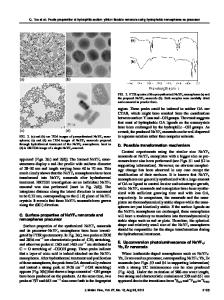Nanorods as a precursor for high quality GaN layers
- PDF / 9,186,807 Bytes
- 6 Pages / 612 x 792 pts (letter) Page_size
- 96 Downloads / 327 Views
1144-LL18-15
Nanorods as a precursor for high quality GaN layers
D Cherns1, I Griffiths1, S Khongphetsak1, SV Novikov2, NRS Farley2, RP Campion2, and CT Foxon2 1 2
Department of Physics, University of Bristol, Tyndall Avenue, Bristol, UK Department of Physics and Astronomy, University of Nottingham, Nottingham, UK
ABSTRACT The density of threading dislocations in GaN/(0001)sapphire films grown by molecular beam epitaxy can be reduced to about 108 cm-2 by growing an intermediate nanorod layer. This paper examines the growth of the nanorods and proposes that threading defects in the overlayer arise either through grain boundaries formed when nanorods coalesce, or through the propagation of dislocation dipoles seen during nanorod growth. Results showing that the latter often terminate or develop into voids during growth are discussed. INTRODUCTION The efficiencies of both light emitting and electronic devices based on GaN are often limited by high densities of threading dislocations, generated by the use of highly mismatched substrates. In our work, we have investigated whether the densities of threading dislocations in GaN/(0001)sapphire films, where the lattice mismatch is about 16% and dislocation densities are often in the range 109 – 1011 cm-2, can be reduced by growing an intermediate layer composed of GaN nanorods. Films have been grown by plasma-assisted molecular beam epitaxy (MBE). As has been known for well over a decade, a transition in MBE-growth of GaN from a relatively smooth twodimensional layer-by-layer growth mode to a three-dimensional island growth mode can be effected by increasing the overpressure of the nitrogen species, i.e. moving from so-called Garich to N-rich conditions . In fact, the growth of well-defined nanorods under a high overpressure of nitrogen has been extensively studied (see [1] for a review). These studies have shown that, in contrast to many examples of nanorod growth, the MBE growth of GaN nanorods is probably catalyst-free [2]. However, the exact morphology can be strongly influenced by surface preparation, in particular, by the initial deposition of a thin AlN buffer layer [3]. In previous work, we have reported that continuous GaN/(0001)sapphire films with intermediate layers of GaN nanorods can be grown by MBE in a single growth run, and that threading dislocation densities were in the range108-109cm-2 in the overlayer [4]. In this paper, we examine the origin of these threading dislocations in more detail. EXPERIMENTAL
GaN was grown on (0001)sapphire using plasma-assisted MBE in a Varian ModGen II system. Following the growth of 2-10nm AlN at a substrate temperature of about 600°C, GaN was grown for up to 6hrs at temperatures of 700 - 800°C under a high pressure of activated nitrogen using an HD25 RF-activated plasma source. The nitrogen pressure was then reduced, and growth was continued for further periods of up to 6hrs. Transmission electron microscopy (TEM) was carried out on samples prepared in crosssectional orientation by mechanical polishing followed by Ar i











